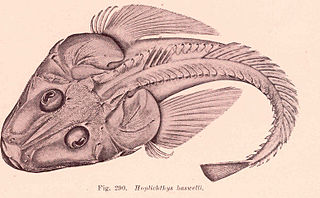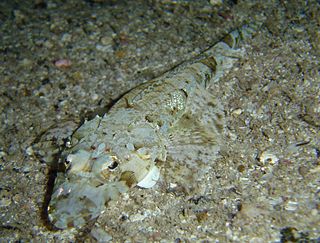
The armoured flathead, also known as the deepsea flathead, glassy flathead or spiny flathead, is a species of marine ray-finned fish of the family Hoplichthyidae, the ghost flatheads. This species is found in the southwest Pacific Ocean.

The Platycephalidae are a family of marine fish, most commonly referred to as flatheads. They are relatives of the popular lionfish, belonging to the order Scorpaeniformes.

Platycephalus is a genus of mostly marine, demersal ray-finned fish belonging to the family Platycephalidae. They are found in the eastern Mediterranean, the Indian Ocean and western Pacific Ocean.

The tentacled flathead, also known as the Indian Ocean crocodilefish, Madagascar flathead or longhead flathead, is a species of marine ray-finned fish belonging to the family Platycephalidae, the flatheads. This species is in the western Indian Ocean, including the Red Sea and the Mediterranean, having invaded as a Lessepsian migrant through the Suez Canal. It is the only species in the monotypic genus Papilloculiceps.

Bembridae, the deep-water flatheads, are a family of bottom-dwelling ray-finned fishes. They are found in the Indian and western Pacific Oceans.

Bembras is a genus of marine ray-finned fish belonging to the family Bembridae, the deepwater flatheads. These fishes are found in the Indian Ocean and the western Pacific Ocean.

Platycephaloidei is a suborder of ray-finned fishes, part of the order Scorpaeniformes, and includes the flatheads, ghost flatheads and sea robins.

Cociella is a genus of marine ray-finned fishes belonging to the family Platycephalidae, the flatheads. These fishes are found in the Indo-Pacific region.

Cymbacephalus is a genus of marine ray-finned fishes belonging to the family Platycephalidae, the flatheads. These fishes are found in the Indo-Pacific region.

Grammoplites is a genus of marine ray-finned fishes belonging to the family Platycephalidae, the flatheads. These fishes are found in the Indo-Pacific region.

Onigocia is a genus of marine ray-finned fishes belonging to the family Platycephalidae, the flatheads. They are found in the Indo-Pacific region.
Ratabulus is a genus of marine, demersal ray-finned fish belonging to the family Platycephalidae. These fishes are native to the eastern Indian Ocean and the western Pacific Ocean.

Rogadius is a genus of marine, demersal ray-finned fish belonging to the family Platycephalidae. These fishes are native to the Indian Ocean and the western Pacific Ocean.
The Guinea flathead is a species of marine ray-finned fish belonging to the family Platycephalidae, the flatheads. It is found in the eastern Atlantic Ocean along the western coast of Africa. This species is the only known member of the genus Solitas. It is also the only flathead species which has a natural distribution which lies outside of the Indo-Pacific.

Insidiator is a genus of marine, demersal ray-finned fish belonging to the family Platycephalidae. These fishes are native to the eastern Indian Ocean and western Pacific Ocean.

Sunagociais a genus of marine, demersal ray-finned fish belonging to the family Platycephalidae. These fishes are native to the Indian and Pacific oceans.

Thysanophrys is a genus of marine, demersal ray-finned fish belonging to the family Platycephalidae. These fishes are native to the Indian Ocean and the western Pacific Ocean.

Plectrogenium, is a genus of marine ray-finned fishes, the stinger flatheads, the only genus classified within the subfamily Plectrogeninae, which in turn is classified within the family Scorpaenidae. This genus is found in the Indian and Pacific Oceans.

Platycephalus bassensis the Southern sand flathead, Bass flathead, bay flathead, common flathead, sand flathead, sandy, sandy flathead, slimy flathead or yanks, is a species of marine ray-finned fish belonging to the family Platycephalidae, the flatheads. It is endemic to Australia.
Cociella martingomoni is a species of marine ray-finned fish belonging to the family Platycephalidae, the flatheads. It is found in the Andaman Sea.


















